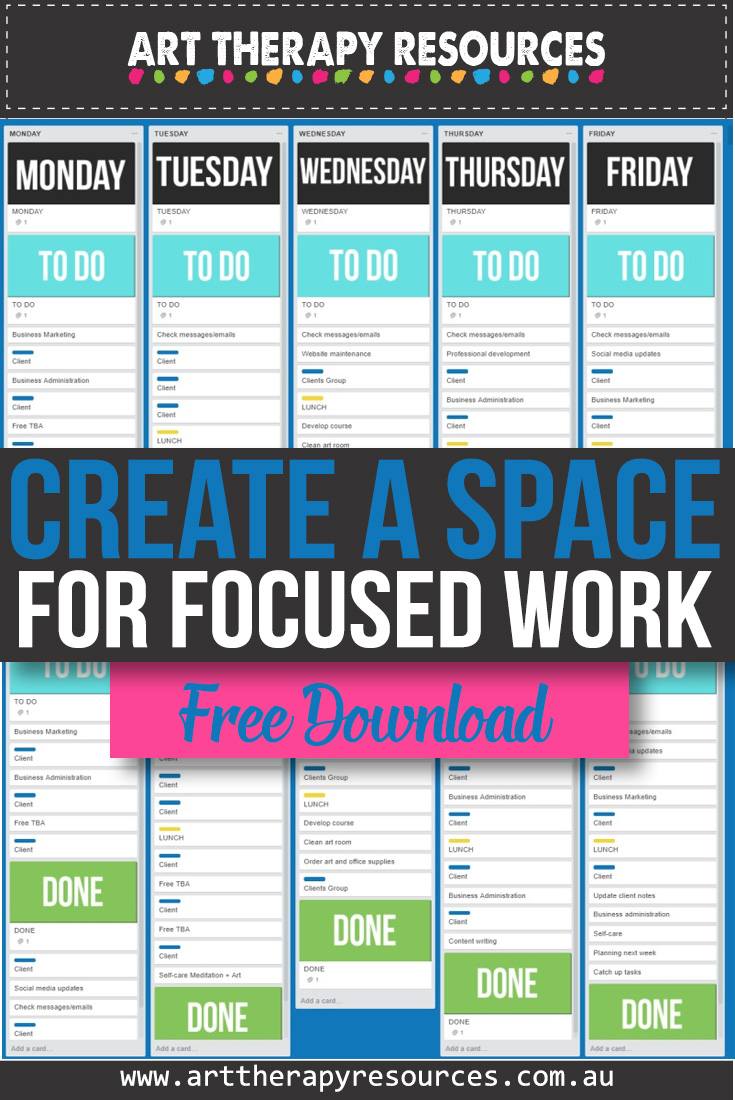THIS POST INCLUDES:
1. Identify your focused work
2. Create a productive work space
3. Accessibility and atmosphere
4. Free Download Trello Organisation Board
IDENTIFY YOUR FOCUSED WORK
Before you create a focused work space, you should identify the type of focused work that you want to undertake. If it is work that requires significant physical space, you should identify those needs. However, if the work you need to do only requires a computer and limited distractions, then you should incorporate those priorities into your space instead.
There is no formula to creating a productive room layout because your requirements are personal to your needs, however, there are some things you should keep in mind when creating a space that will support your needs to undertake focused work.
As a private practice therapist, below are some suggestions for identifying the work you want to focus on in your business:
- Define your business goals: Start by clarifying your business goals and objectives. What are your short-term and long-term goals? Understanding your business goals will help you identify the work that will best help you achieve them.
- Assess your strengths: Evaluate your skills, experience, and knowledge. Identify the tasks and projects that you excel at and that you enjoy doing. This will help you identify the work that you should focus on.
- Analyze your customer needs: Understand the needs and expectations of your customers. Identify the services or products that are in high demand and the ones that generate the most revenue. This will help you identify the work that will provide the greatest value to your customers.
- Understand your therapy practice needs: Identify the areas where you have a competitive advantage and the areas where you need to improve. This will help you prioritize the work that will help you address your weaknesses and take advantage of your strengths.
Identifying the work you want to focus on can provide a practical opportunity to develop useful pathways that will contribute to improving the success of your private practice. It can also help you identify where you may want to develop personal and professional interests in your therapy practice.
This could mean focusing on attracting an ideal client that suits your interests, or it could mean exploring a new avenue of work within your practice such as group work, conferences, or community work.
CREATE A PRODUCTIVE WORK SPACE
Creating a productive workspace involves several factors that can contribute to your overall work efficiency and motivation. Your space should encourage productivity as well as feel comfortable through the use of colors, textures, smells, and sounds.
Below are some tips on how to create a productive workspace:
- Choose the right location that is quiet, well-lit, and away from distractions. Ensure that you have adequate space to move around comfortably.
- Invest in a comfortable chair and desk that is comfortable and supports your posture. A desk that is the right height for you and has enough space to accommodate your work materials is also essential.
- Organize your workspace and keep it clutter-free. Have a designated space for your equipment, files, and other items you need to work.
- Use proper lighting such as natural light or a well-positioned lamp. Avoid glare and shadows that can strain your eyes and affect your productivity.
- Personalize your space with items that inspire you or make you happy. This can include plants, pictures, or other decor that makes you feel relaxed and motivated.
- Minimize distractions such as noise or social media. Consider using noise-cancelling headphones or taking breaks to help minimize distractions.
- Set boundaries with your coworkers, family, or friends to avoid interruptions during work hours. Establish clear work hours and communicate them to those around you.
By implementing these tips, you can create a workspace that is comfortable, organized, and conducive to productivity.
Once you have your workspace organized you can also implement steps to your workflow that results in being able to sit down and access your work asap so that you are not distracted by other (possibly more enticing) activities.
ACCESSIBILITY AND ATMOSPHERE
In addition to creating a functional space, you can introduce other items into your space to help foster a productive and engaging space for you to work.
Some common items you can add to your space include:
- Plants
- Inspiring images
- Inspiring quotes
- Soft furnishings (rugs, pillows)
- Sitting areas for reading or talking
- Music
- Soft lighting – candles, string lights etc
If your office space is part of your client space, you will need to consider the impact of having office resources in a space that is dedicated to therapeutic treatment. This might mean using a laptop instead of a desktop computer so it can be easily stored away between work sessions. You may also want to consider a locked cupboard that holds all of your office items but is also easily accessible when you want to undertake focused administrative work.
FREE DOWNLOAD: Trello Board Template
Download the FREE Trello board template which contains a weekly layout you can use to plan your focused work.
BUILD YOUR ART THERAPY REFERENCE MATERIALS:
Pin this image to your Pinterest board.

SHARE KNOWLEDGE & PASS IT ON:
If you’ve enjoyed this post, please share it on Facebook, Twitter, Pinterest. Thank you!
